Battle of the Retros: Royal Enfield Interceptor 650 v BSA Gold Star
Royal Enfield Interceptor 650
When I rode this at the launch in California, I remember thinking that Royal Enfield had created my perfect motorcycle.
Perfect because it captures the pure and simple joy of biking which sometimes gets buried under the pile of gizmos many machines come with.
And perfect because it recaptures the same pure and simple joy of my first big bike adventure, when Paddy Minne and I rode two Enfield Bullet 500s from India back to the UK in 1998 for my book Way to Go.
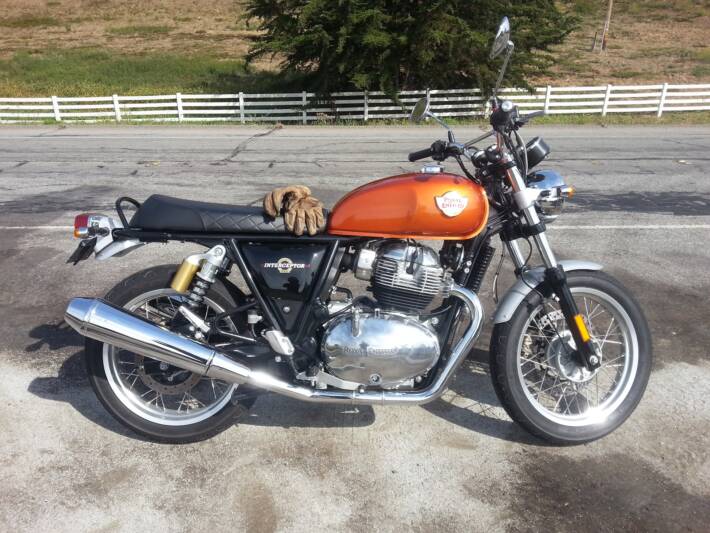
They looked beautiful, but were made of tinfoil and hope, to the extent that pretty much every bit that could vibrate its way loose would regularly do so, then fling itself into the road with gay abandon.
And although the quality of Enfields improved beyond measure since then, they’d all mostly been variations on the 500 Bullet that Paddy and I rode – until the 2019 launch of the Interceptor and the café racer version the Continental GT, the first Enfield parallel twins since the 700cc 1960s Interceptor.
And I wasn’t alone in loving it: in the year after its launch, it was the best-selling middleweight bike in the UK, and in June 2020 overtook the usually all-conquering BMW R 1250 GS in all UK sales over 125cc.
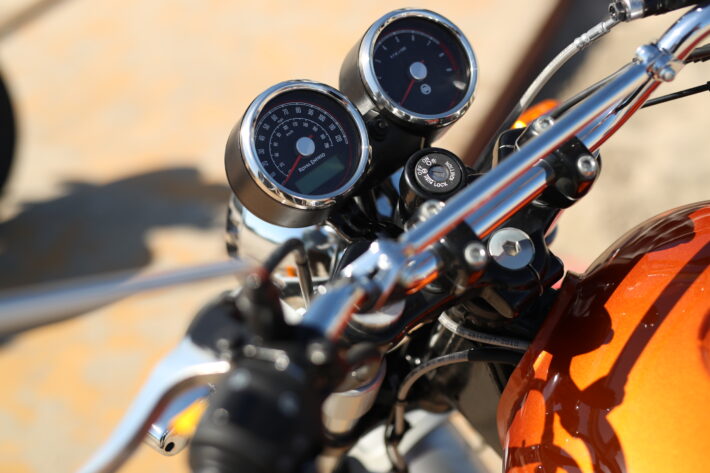
Enfield had started with plans for a 600cc machine, dithered briefly with thoughts of making it 800cc, then went for 650cc for a gap in the market not filled by any other retro bike.
And during the four years of development under inspired figures such as ex-Triumph head of production Simon Warburton and industrial design guru Mark Wells, the keep it simple stupid philosophy behind every decision was that if an idea didn’t add anything to the bike, it didn’t happen.
As a result, when you climb on board the Interceptor, the view is simplicity itself: a speedo, tacho and small digital panel with odometer and fuel display.
The riding position, unlike that of the Continental GT which throws your weight forward onto the bars and can get a bit uncomfortable after a while, is upright, neutral and all-day comfortable.
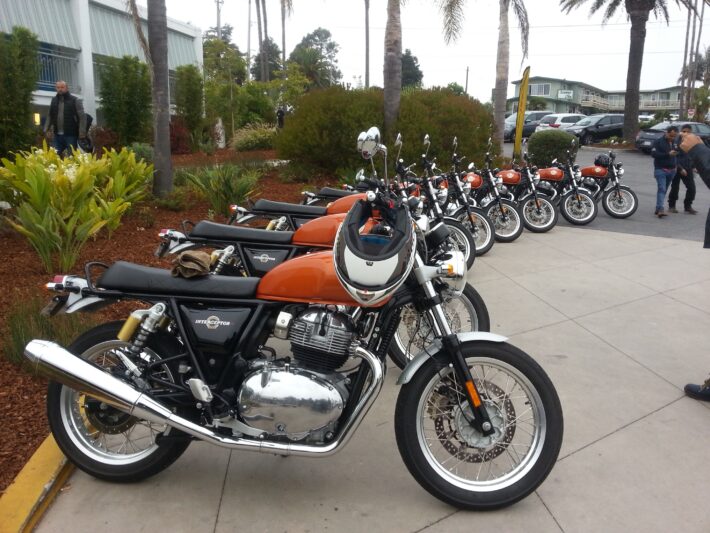
Start up, and the air fills with the happy burble of a machine quietly pleased with life and its place in it. Courtesy of a 270-degree crank, it’s a lovely offbeat sound, like the love child of a parallel twin and a V-twin, and at speed becomes a satisfying growl, made even more satisfying if you fit the aftermarket S&S pipes for a deliciously visceral snarl.
Acceleration is swift and seamless, and with 80% of torque available from 2,500rpm and a torque curve as flat as Holland, beautifully smooth all the way through maximum torque at 5,250rpm then maximum power at 7,250rpm, after which you hit the red line and there’s no point thrashing it to death.
There’s no need to anyway, since it’s so torquey that I spent much of the day in third around mountain corners, opening up to fourth for short straights in between.
It’s made even more seamless by the perfect marriage of a slick six-speed gearbox, Enfield’s first, and a featherlight slip-assist clutch as light as a hot knife through a well-buttered cliché.
In sixth for a long blast down Pacific Coast Highway at 70mph, the engine was purring away at 4,000rpm and entirely happy at up to 90mph, although at that stage you start to get a bit windblown.
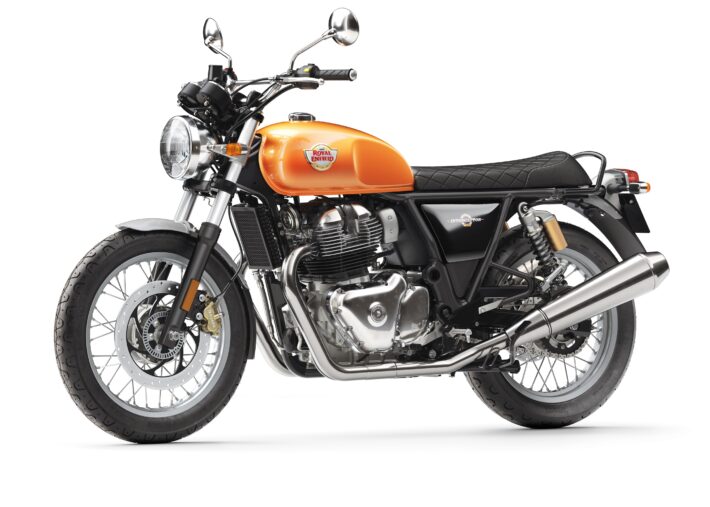
As for handling, the design team at Enfield’s £60 million UK tech centre at Bruntingthorpe tweaked combinations of rake, trail, frame and suspension thousands of times to get it right, and it shows, with cornering which is beautifully light and neutral.
The suspension alone is a work of art: pliant enough to soak up bumps, but firm enough for precise and planted carving through corners.
There’s only one disc up front, but with the bike weighing only 217kg even with the 13.7 litre tank filled to the brim, that’s all it needs, particularly since the feel from the front for most braking, and the rear for trail braking through downhill corners, is firm and progressive.
Add all this together, and the result is a sublime symphony of engine, suspension, handling and balance which is greater than the sum of the parts and a blissful marriage of old school form and state-of-the-art function.
BSA Gold Star
I know, I’m such a tart: first I declare the Interceptor the perfect bike, then I fall in love with the Gold Star at first glance.
At one stage BSA was one of the most successful manufacturers in the world, making legendary machines such as the 496cc single Gold Star from 1938 to 1963, named after Wal Handley lapped Brooklands at over 100mph on a BSA Empire Star and was awarded a Gold Star pin in recognition.
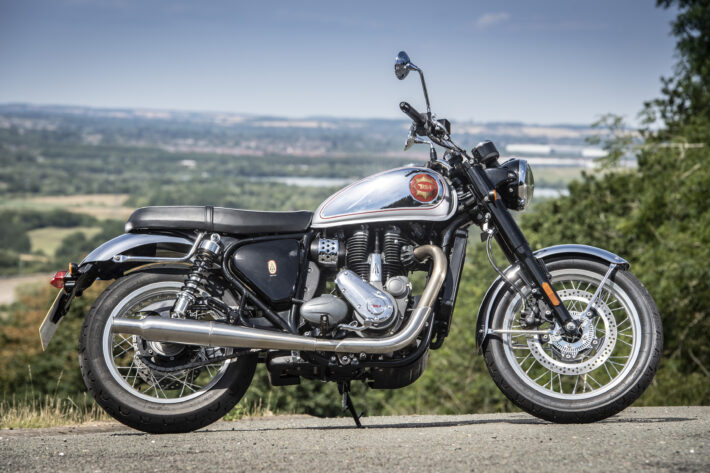
Sadly, like most of the British bike industry, a combination of poor management, union disagreements and the influx of fast, reliable Japanese bikes led to its demise in 1973.
Then in 2016 the BSA name and rights were bought by Indian giant Mahindra, and its first new model revives the Gold Star name.
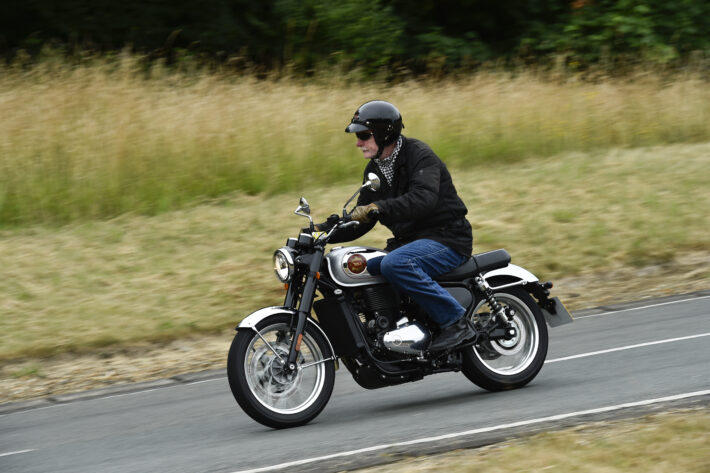
And you know what – it’s absolutely gorgeous, especially the Legacy model, with chrome tank, mudguards, mirrors and levers and polished engine covers.
Hence the love at first sight, since Mahindra wisely decided to tap into the same vibe as Royal Enfield with the Interceptor – beautifully classic looks, but modern reliability and performance.
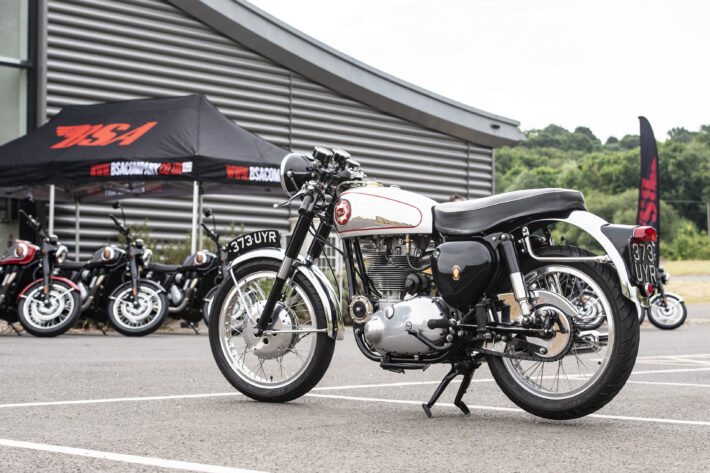
Climb aboard, and the riding position and view is suitably retro, down to the round mirrors and twin analogue speedo and tacho, on which the needles work upside down compared to normal, as on the original Gold Star.
“And because life should be fun,” laughed BSA Director Ashish Singh Joshi. Earlier, asked why the company had decided on a single rather than a twin, he’d said in homage to the original Gold Star, and because it gave the perfect combination of smoothness, character and charm.
Although it’s liquid-cooled, the radiator is discreet enough not to be noticed.
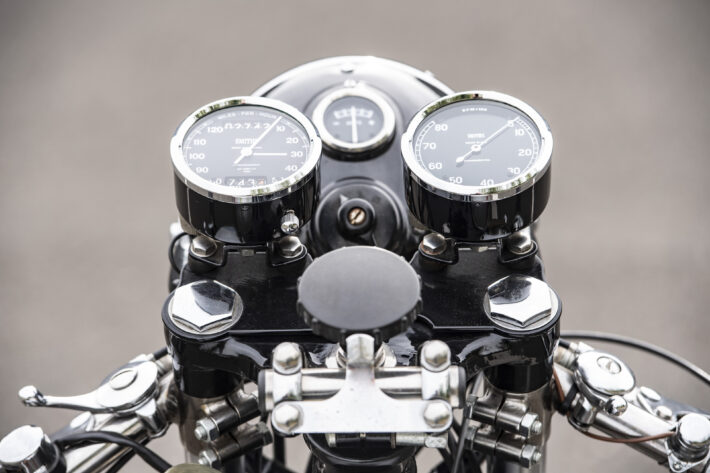
The only slightly jarring point is switchgear which is a bit plasticky and at odds with the retro look of the rest of the bike, but that’s a minor detail.
Start up, and the air fills with a happy purr like a well-fed kitten, rising to a civilised growl at speed.
For a 45bhp single, progress is surprisingly perky as you snick through the five-speed box, helped by most of the torque being available from as little as 2,500rpm all the way to max at 4,000 and maximum power at 6,500.
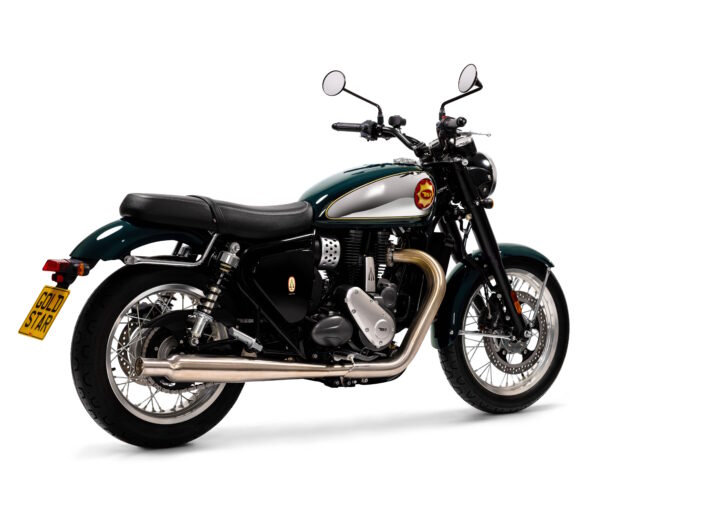
I got it smoothly up to 90mph before I ran out of road, and I have no doubt that Ashish’s claim it will do the ton is true.
Handling, with the bike weighing 213kg and a low centre of gravity, is almost too light, but I suspect that’s because I’m taller and heavier than the average biker. Normal riders should find it entirely fine, but beefier ones can firm up the rear suspension if needed.
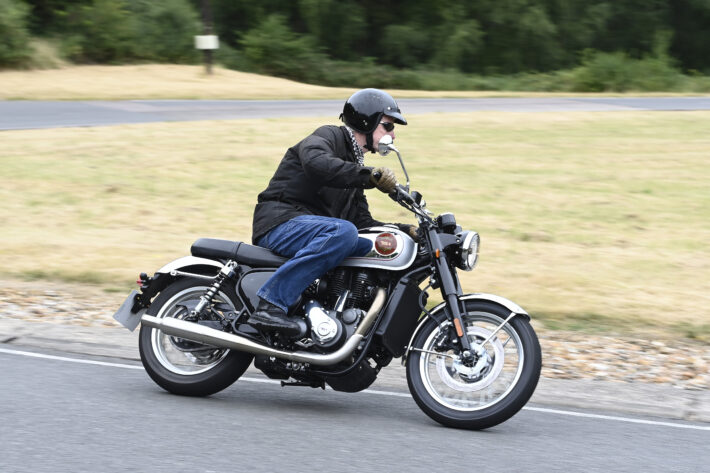
There’s only one disc up front, but it’s entirely adequate, although steaming into some downhill corners with a little too much enthusiasm, I needed to bring the rear into play to help out.
All in all, a very satisfying and beautiful package for retro motorcycling with surprising oomph for a single.
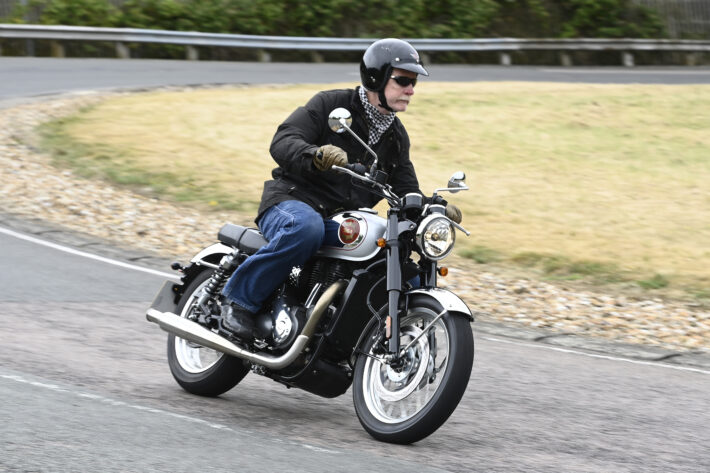
Future Mahindra plans include more powerful models and electric bikes, but as a first step, this is a beautiful and perky machine which will put a smile on the face of anyone who rides it.
The verdict
For BSA, the only fly in the proverbial is the fact that the aforementioned Royal Enfield Interceptor 650 is £6,199 for single colour to £6,699 for the luscious chrome version, and the Gold Star is £6,500 to £7,000 for its equally gorgeous Legacy version.
The Enfield weighs about the same, and has slightly more power but slightly less torque, and to me the Gold Star looks better.
Given the choice, I’d go for the chrome and red Interceptor – then splash out £946.80 for the S&S big bore kit which increases the cc from 650 to 865 and the power from 47bhp to 70.
Now that would be one heck of a motorbike: fast, beautiful and with the same pinpoint handling. It’s on my bucket list, so watch this space. I’ll be the one leaving it at speed with a smile on my face.
The facts
Royal Enfield Interceptor 650
Engine: 648cc air-cooled parallel twin
Power: 47bhp @ 7,250rpm
Torque: 38 lb ft @ 5,150rpm
Price: From £6,199
Colours: black; blue; red; green; chrome/red; black/pearl; black/red
BSA Gold Star
Engine: 652cc liquid-cooled single
Power: 45bhp @ 6,500rpm
Torque: 41 ft lb @ 4,000rpm
Colours: Black; red; green; silver
Price: From £6,500
Former Sunday Times and Daily Mirror motorbike columnist Geoff Hill has joined the Devitt team to bring decades of alleged motorcycling wisdom – and at 6ft 7ins, some much-needed height.
He’s been testing bikes since 1998, has ridden pretty much everything out there, and kicks off with a series of comparisons on everything from full fat adventure bikes to scooters.

One comment on “Battle of the Retros: Royal Enfield Interceptor 650 v BSA Gold Star”
NIce and easy to read. Love the look of both. Some might be interested in making them more powerful but does it really need it. I don’t think so.